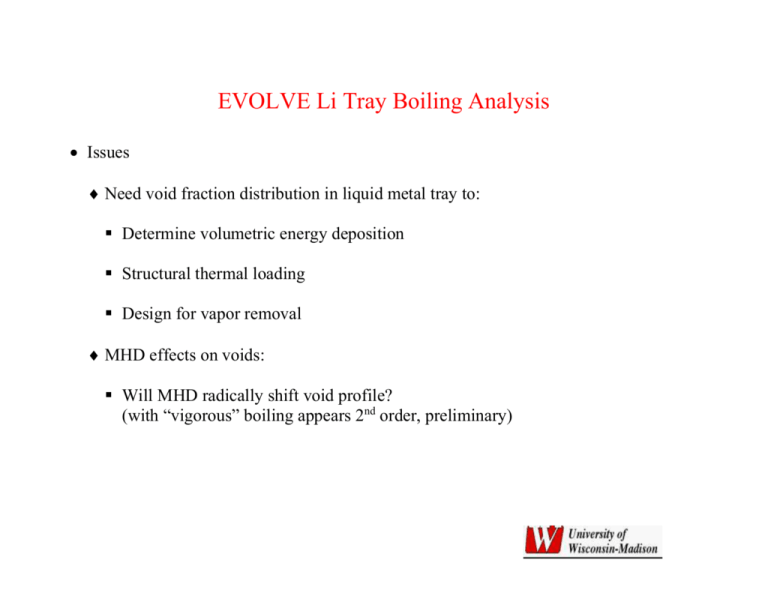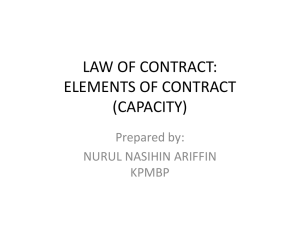Iteration Process for Determining Void Fraction Distribution
advertisement

EVOLVE Li Tray Boiling Analysis Issues Need void fraction distribution in liquid metal tray to: Determine volumetric energy deposition Structural thermal loading Design for vapor removal MHD effects on voids: Will MHD radically shift void profile? (with “vigorous” boiling appears 2nd order, preliminary) Preliminary Void Fraction Determination Divide 50 cm tray into “channels” and predict void distribution in each channel Channel sizing calculation ( Taylor length scale) width 2 3 g width = 8cm, is a maximum bubble size (channel should be at least this wide) (for simplicity a channel size of 10 cm was chosen) = surface tension (N/m) g = gravity constant = liquid-vapor density difference (kg/m3) Mohamed Sawan (UW) provided nuclear heating (W/cm3) distribution for OB tray which gives generation rates for W and Li Uniform void distribution of 17% used for first calculation 25 zone Li pool (5 radial channels, 5 vertical positions) Preliminary Void Fraction Determination Nuclear heating (W/cm3) distribution in OB tray 98.9 99.4 100.7 101.7 102.5 104.6 103.2 104.0 28.3 28.2 28.2 28.4 28.7 90.3 22.1 21.9 21.8 21.9 22.2 72.0 17.6 17.4 17.4 17.4 17.5 58.4 14.5 14.2 14.2 14.2 14.3 48.2 FW represented by 0.6 cm thick zone Trays have 50 cm radial thickness and 15 cm height Tray bottom and back W plates are 0.5 cm thick OB neutron wall loading is 10 MW/m2 Use energy deposited in Li and W to determine the vaporization rate 12.6 12.2 12.1 12.0 12.2 40.3 40.4 39.2 38.1 37.1 36.3 34.4 Preliminary Void Fraction Determination The material (Li) vaporized is used to determine the volumetric vapor flux (jg) and the dimensionless superficial gas velocity used in the churn-turbulent flow model Empirical study of void fraction in a pool configuration with upward flowing gas (bubbly or churn-turbulent flow regime, Casas & Corradini) Drift-flux model used void Jg Co Jg C1 Jg jg f ( f g ) g f 2 1/ 4 Z f f f ( f g ) g 1/ 2 f 1/ 2 jg mg gA Co and C1 experimentally determined coefficients from tests with mercury, woods metal, water, Freon, dodecane, and silicone oils Preliminary Void Fraction Determination Jg Co C1 Z h*o mg = dimensionless superficial gas velocity = 0.248 ln(Z) + 3.52 = 0.502 h*o + 7.27 10-3 ln(Z) – 0.124 h*o ln(Z) – 0.0295 = Ohnesorge Number = dimensionless pool depth (height/diameter, 15 cm/10 cm) = vapor mass flow rate jg f f f g A = volumetric vapor flux = fluid surface tension = fluid viscosity = fluid density = vapor density = channel area Void fractions are driven by Li vapor density (ideal gas calculation) and by nuclear heat loads applied to the Li and W Provided below is a plot of void fraction versus superficial gas velocity (Jg) at 1473 K and 0.037 MPa (most Jg values are above 5) Void Fraction (calculated) Void vs. Jg 0.8000 0.6000 0.4000 0.2000 0.0000 Series1 0 5 10 Jg 15 20 Preliminary Void Fraction Determination The superficial gas velocity scales directly to nuclear heating, but you can see that at sufficiently high (~ 5) values changes in nuclear heating minimally affect void fraction Assumed void fraction 17% for original nuclear heating values As void changes the deposition heating rates will change, ultimately the initial void fraction will be iterated on to converge to some value On the next page is the void profile for heating values corresponding to 17 % voids, 1473 K (0.037 MPa) and 1673 K (0.17MPa) To accurately assess, void fraction must be matched with heating (iteration necessary) Preliminary Void Fraction Determination Void Fraction Channel Void Fraction (1473 K, .037 MPa, 17% void for nuclear heating) 0.6800 0.6300 0.5800 0.5300 0.00 5.00 10.00 15.00 20.00 Vertical Channel Position (cm) Channel 1 Channel 2 Channel 3 Channel 4 Channel 5 Void Fraction Channel Void Fraction (1673 K, .17 MPa, 17% void for nuclear heating) 0.5600 0.4800 0.4000 0.3200 0.00 5.00 10.00 15.00 20.00 Vertical Channel Position (cm) Channel 1 Channel 2 Channel 3 Channel 4 Channel 5 Iteration Process for Determining Void Fraction Distribution Volumetric heating is lower for higher void fractions As first order approximation nuclear heating in the Li is scaled linearly with density - Neutron attenuation in Li changes with void fraction affecting nuclear heating in Li at back of tray, W back plate, and W bottom plate Calculations repeated till convergence Iterations with neutronics calculations will then start This approach speeds up the iteration process The higher void fraction (compared to the assumed 17% average value) will reduce TBR and increase structure damage. Once the void fraction distribution is finalized, nuclear performance parameters will be updated Conclusions Voids appear to be significant (mainly because of low operating pressure) Drift-flux model Magnitude of nuclear heating 2nd order, when Jg large (>5) Low pressure ensures large voids at channel exit (currently using ideal gas formulation, need accurate Li vapor properties) Void fraction approaches 1/Co as volumetric vapor flux (jg) increases MHD effects Just beginning to review With “vigorous” boiling, MHD appears to be 2nd order Lykoudis paper







